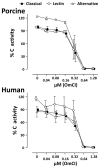Ornithodoros moubata complement inhibitor is an equally effective C5 inhibitor in pigs and humans
- PMID: 21964028
- PMCID: PMC3359935
- DOI: 10.4049/jimmunol.1101000
Ornithodoros moubata complement inhibitor is an equally effective C5 inhibitor in pigs and humans
Abstract
Experimental evidence suggests that C inhibition and more particularly combined inhibition of C and the TLR coreceptor CD14 may be of therapeutic benefit in sepsis and other inflammatory conditions. A barrier to the testing and further development of many inhibitors is that their activity is species specific. Pig is a relevant species for experimental models of human disease, and this study undertakes a comprehensive comparison of the inhibitory efficacy of the C5 inhibitor Ornithodoros moubata C inhibitor (OmCI) in human and porcine whole blood ex vivo models of Escherichia coli-induced sepsis. The effect of OmCI on complement activity in pigs undergoing E. coli sepsis was also examined. Porcine and human serum, and whole blood anticoagulated with lepirudin, was incubated with E. coli and the effect of OmCI investigated. The ex vivo results were virtually identical in pig and human. OmCI completely ablated the activity of all three C pathways at 0.64 μM. E. coli-induced C activation and expression of CD11b (wCD11R3 in the pig), was abolished ex vivo at 0.32 μM OmCI. Combining anti-CD14 and OmCI reduced the formation of IL-8 and TNF-α more potently than the single inhibitors. OmCI also efficiently bound E. coli-induced leukotriene B(4) in pig and human plasma. In support of our ex vivo findings, in vivo the activity of all C pathways was inhibited at 0.6 mg OmCI/kg pig. In conclusion, OmCI efficiently inhibited pig and human C activation, has accompanying anti-inflammatory effects and is a promising candidate inhibitor for further in vivo studies of sepsis.
Figures






Similar articles
-
Complement inhibitor of C5 activation from the soft tick Ornithodoros moubata.J Immunol. 2005 Feb 15;174(4):2084-91. doi: 10.4049/jimmunol.174.4.2084. J Immunol. 2005. PMID: 15699138
-
Combined inhibition of complement C5 and CD14 markedly attenuates inflammation, thrombogenicity, and hemodynamic changes in porcine sepsis.J Immunol. 2013 Jul 15;191(2):819-27. doi: 10.4049/jimmunol.1201909. Epub 2013 Jun 12. J Immunol. 2013. PMID: 23761634
-
Design and Biological Evaluation of the Long-Acting C5-Inhibited Ornithodoros moubata Complement Inhibitor (OmCI) Modified with Fatty Acid.Bioconjug Chem. 2024 May 15;35(5):653-664. doi: 10.1021/acs.bioconjchem.4c00126. Epub 2024 Apr 9. Bioconjug Chem. 2024. PMID: 38593046
-
Differential effect of inhibiting MD-2 and CD14 on LPS- versus whole E. coli bacteria-induced cytokine responses in human blood.Adv Exp Med Biol. 2012;946:237-51. doi: 10.1007/978-1-4614-0106-3_14. Adv Exp Med Biol. 2012. PMID: 21948372 Review.
-
Controlling the complement system in inflammation.Immunopharmacology. 1997 Dec;38(1-2):51-62. doi: 10.1016/s0162-3109(97)00057-x. Immunopharmacology. 1997. PMID: 9476114 Review.
Cited by
-
Deciphering Biological Processes at the Tick-Host Interface Opens New Strategies for Treatment of Human Diseases.Front Physiol. 2019 Jul 3;10:830. doi: 10.3389/fphys.2019.00830. eCollection 2019. Front Physiol. 2019. PMID: 31333488 Free PMC article. Review.
-
Bifunctional lipocalin ameliorates murine immune complex-induced acute lung injury.J Biol Chem. 2013 Jun 28;288(26):18789-802. doi: 10.1074/jbc.M112.420331. Epub 2013 Apr 26. J Biol Chem. 2013. PMID: 23625922 Free PMC article.
-
Effect of O. porcinus Tick Salivary Gland Extract on the African Swine Fever Virus Infection in Domestic Pig.PLoS One. 2016 Feb 1;11(2):e0147869. doi: 10.1371/journal.pone.0147869. eCollection 2016. PLoS One. 2016. PMID: 26828597 Free PMC article.
-
Structural basis for therapeutic inhibition of complement C5.Nat Struct Mol Biol. 2016 May;23(5):378-86. doi: 10.1038/nsmb.3196. Epub 2016 Mar 28. Nat Struct Mol Biol. 2016. PMID: 27018802 Free PMC article.
-
Post challenge inhibition of C3 and CD14 attenuates Escherichia coli-induced inflammation in human whole blood.Innate Immun. 2014 Jan;20(1):68-77. doi: 10.1177/1753425913482993. Epub 2013 May 13. Innate Immun. 2014. PMID: 23669326 Free PMC article.
References
-
- Medzhitov R, Janeway C., Jr Innate immunity. N Engl J Med. 2000;343:338–344. - PubMed
-
- Matzinger P. The danger model: a renewed sense of self. Science. 2002;296:301–305. - PubMed
-
- Walport MJ. Complement. First of two parts. N Engl J Med. 2001;344:1058–1066. - PubMed
-
- Muller-Eberhard HJ. Molecular organization and function of the complement system. Annu Rev Biochem. 1988;57:321–347. - PubMed
Publication types
MeSH terms
Substances
Grants and funding
LinkOut - more resources
Full Text Sources
Other Literature Sources
Research Materials
Miscellaneous

